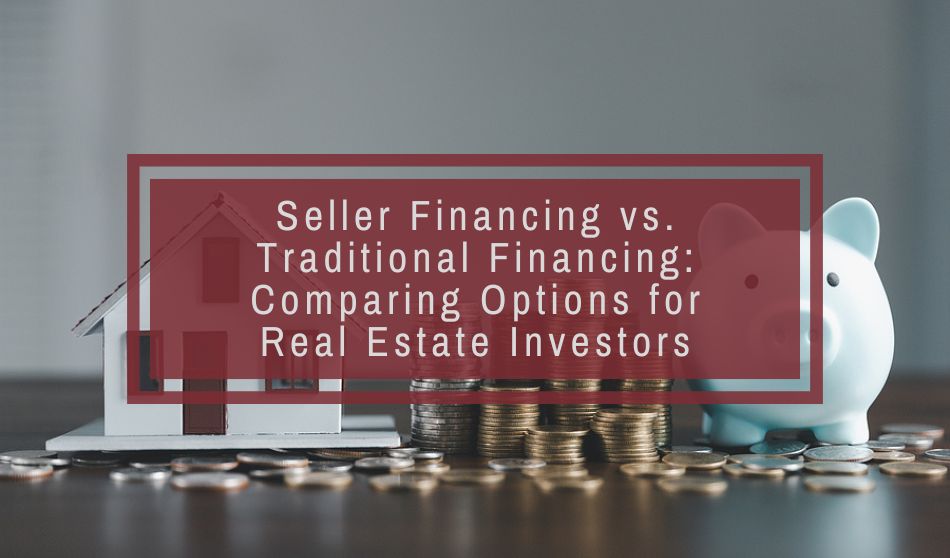
Understanding the ins-and-outs of seller financing (aka owner financing) can be helpful as you grow your portfolio. While there are advantages to seller financing, as with any form of financing, there are downsides. Here is what you should know as an investor looking to purchase real estate.
Whether you’re an experienced real estate investor or just getting into the market, understanding the money side of the equation before making an offer is critical. Too many investors don’t know the options for financing an investment, which can cost them in the long run.
Traditional mortgages work for many. But one of the lesser-known but potentially profitable alternatives is seller financing. Let’s take a closer look at what you need to know about these strategies and their major advantages and possible drawbacks.
What is seller financing?
Seller financing (also sometimes called owner financing) refers to situations where the current property owner acts as the lender rather than a bank or other financial institution. The buyer and seller draw up an agreement reflecting their negotiated terms, and the down payment and regular monthly payments are paid right to the seller. Until the loan is fully paid off, the seller usually retains the right to repossess the property if payments aren’t made.
Advantages Of Seller Financing
To be sure, most sellers can’t or won’t offer financing to buyers. But in situations where it’s available, seller financing can be a significant benefit to buyers in several ways.
More Flexible Terms
Unlike somewhat rigid banks or mortgage lenders, a single person is involved in lending the money, so everything is open to negotiation. You’ll likely need to hire a realtor and a real estate attorney to hammer out the details, but feel free to negotiate interest rates, down payments, and repayment schedules.
Potentially Easier To Qualify
Even smaller banks are bound by their financial institutions’ strict lending requirements. But with seller financing or other creative financing, all you’ll need is the approval of the current owner. This can help those who don’t have stellar credit or income history and avoid possible problems like low appraisals. That makes it a good workaround for new investors who might be stretched a little thin on their first few deals.
Closing Can Be Fast
Anyone who’s gotten a traditional mortgage knows how lengthy the process can be, with extensive paperwork, underwriting, and repeated checks on your credit and income. Seller financing can move much faster, typically as quickly as the papers can be drawn up and reviewed by both sides once an agreement is reached.
Sellers Can Generate Income
Sellers wouldn’t agree to owner financing if something weren’t in it for them (beyond saving money on listing and buyer’s agent commissions and other agent fees). Seller financing provides interest income to the seller during the term of the loan, just like traditional financing does for a bank.
Disadvantages of Seller Financing
Still, like any source of financing, there are some possible downsides, too.
Rates And Terms May Be Tough
Because the seller assumes so much risk and may not have a portfolio of other deals to balance it out, interest rates are typically higher than traditional financing. They may also have a balloon payment, which will be far larger than the others, and pay off the balance at the end of the loan. Many investors bank on refinancing to resolve this problem, but those who can’t risk losing their property.
Loan Amounts May Be Smaller
Some sellers may be unwilling to finance the entire cost of the property, especially if a buyer is not well-qualified. If you’re a buyer looking to obtain seller financing, be prepared to come up with a more significant down payment.
Sellers Are On The Hook For The Consequences Of Default
Lending money is risky; if a buyer defaults, the costs for the seller can exceed the loan terms. Repairs may be needed if a buyer defaults and has not maintained the property. Additionally, the foreclosure process can be costly and time-consuming.
What is traditional financing?
When people think of real estate purchases, traditional financing is the form that most commonly springs to mind. It refers to mortgages from a bank, credit union, or other institutional lender.
Advantages Of Traditional Financing
As millions of Americans discover every year, there’s a lot to like about ordinary mortgages for many buyers and investors.
Interest Rates Are Lower
Although there can be variations in seller financing, interest rates for conventional financing are usually lower, sometimes by many percentage points. Buyers can also pay points on their interest rates to reduce them further — something that’s not available in seller financing.
Loan Terms Are Longer
Some sellers may be interested in carrying a loan longer than a handful of years, but these are typically the exception. Traditional loans have longer repayment terms of 15 or 30 years, making monthly payments more manageable.
Larger Loan Amounts Are Possible
Because of their size and reach, banks and credit unions can offer larger loan amounts. This is a better option if you are looking to invest in a larger single-family home, apartment building, or other more expensive real estate.
The Lending Process Is Established
With so much up in the air in real estate investments, it can be comforting to have a time-tested, regulated lending process to fall back on. With traditional loans, you know exactly what to expect.
Disadvantages Of Traditional Financing
The same things that make traditional mortgages appeal to some buyers influence many drawbacks, too.
Qualification Requirements Are Strict
Borrowers must meet strict credit and income requirements to finance an investment property using a bank or credit union. These can vary based on the loan program you are participating in, but poor credit, lack of income, or short credit history can quickly disqualify you from a traditional loan.
The Traditional Loan Process Can Be Lengthy
Even in a slow market, the closing process can take what feels like a lifetime. Depending on the loan’s type and size, it can take a month or longer. The paperwork is time-consuming, and the verification steps can each take a long time.
There Is Little Flexibility
Lenders set the terms and conditions of a traditional loan, and there is little room for negotiation. Outside of paying points for a lower rate, borrowers are expected to accept the loan as-is.
Fees And Closing Costs
Fees and closing costs are part of traditional loans that can add tens of thousands of dollars to the property’s price. Some can be rolled into the loan, but others must be paid at closing.
What To Consider For Seller Financing Vs. Traditional Financing
When you find an investment opportunity you are excited about, you might be tempted to leap into a deal, but there are a few things you need to weigh regardless of the type of financing you choose. Make sure you’re clear on:
- The term of the loan
- The interest rate
- The required down payment
- The amortization schedule
Each affects your borrowing costs and can make a big difference when trying to save money on investment expenses. Take the time to analyze the advantages and disadvantages of seller vs. traditional financing to find which option works best for you.





Very informative!
Understanding the differences between seller financing and traditional financing is crucial for real estate investors.
Great comparison!